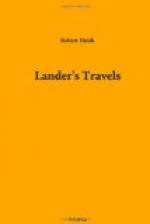The first day of spring is at Sockna a day of general rejoicing. It is then the custom, to dress out little tents or bowers on the tops of the houses, decorating them with carpets, jereeds, shawls, and sashes. A gaudy handkerchief on a pole, as a standard, completes the work, which is loudly cheered by the little children, who eat, drink, and play during the day in these covered places, welcoming the spring by songs, and crying continually, “O welcome spring, with pleasure bring us plenty.” The women give entertainment in their houses, and the day is quite a holiday. From the top of the houses in which Captain Lyon lodged, these little bowers had a very pretty effect, every roof in the town being ornamented with one. Four ears of corn were this day seen perfectly ripe, which was very early for the season. The gardens here are excellent, compared with the others in Fezzan.
Ten miles east by south from Sockna is the town of Hoon. It is smaller than Sockna, but is built and walled in the same manner. It has three gates, three mosques, and a large building, which is dignified with the name of a castle, but it does not appear to have even a loop-hole for musketry. The palm groves and gardens come up close to the walls of the town, and completely conceal it. The soil is sand, but is fertilized by being constantly refreshed by little channels, from wells of brackish water. The inhabitants, who are of the tribe Fateima, bear a good character.
The town of Wadan is between twelve and thirteen miles east by north of Hoon. It appeared much inferior to either of the other two in point of neatness, comfort, and convenience; although its aspect is much more pleasing; it is built on a conical hill, on the top of which are some enclosed houses, called the castle. Here is a well of great depth, cut through the solid rock, evidently not the work of the Arabs. The tombs and mosques, both here and at Hoon, were ornamented with numbers of ostrich eggs. The inhabitants of Wadan are sheerefs, who are the pretended descendants of the prophet, and form the bulk of the resident population, and Arabs of the tribe Moajer, who spend the greater part of the year with their flocks in the Syrtis. A few miles eastward of the town, there is a chain of mountains, which, as well as the town itself, derives its name from a species of buffalo called wadan, immense herds of which are found there. The wadan is of the size of an ass, having a very large head and horns, a short reddish hide, and large bunches of hair hanging from each shoulder, to the length of eighteen inches or two feet; they are very fierce. There are two other specimens found here, the bogra el weish, evidently the bekker el wash of Shaw, a red buffalo, slow in its motions, having large horns, and of the size of a cow; and the white buffalo, of a lighter and more active make, very shy and swift, and not easily procured. The wadan seems best to answer to the oryx.




